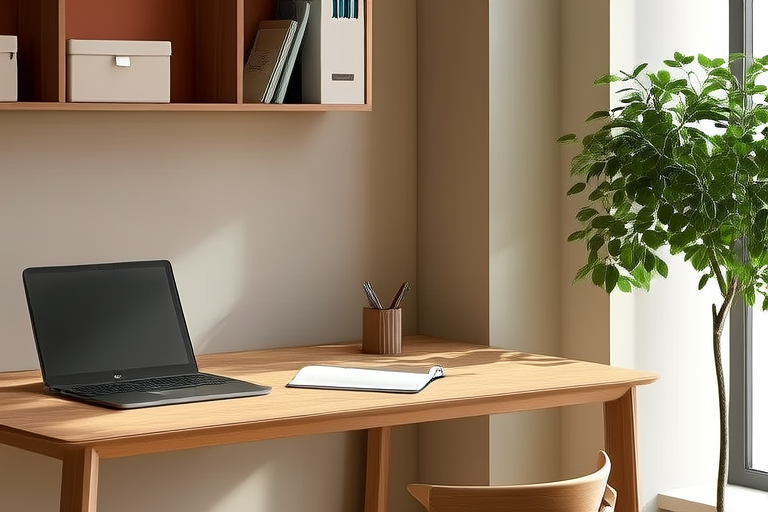Decluttering Made Easy: Simple Strategies for Better Home Office & Desk Management
Introduction
In today’s fast-paced world, maintaining a clean and organized home office or desk can significantly enhance productivity and reduce stress. A cluttered workspace not only hampers your efficiency but also affects your mental well-being. This article will guide you through simple yet effective strategies to declutter your home office and desk, ensuring that you create an environment conducive to focus and creativity.
Understanding the Impact of Clutter
Before diving into the decluttering process, it’s essential to understand why a tidy workspace is crucial. Clutter can lead to distractions, making it harder to concentrate on tasks. Moreover, a disorganized space can increase stress levels, which in turn reduces your ability to think clearly. By keeping your office and desk organized, you’ll find it easier to locate items when needed, reducing frustration and saving time.
The Psychology Behind Decluttering
Psychologists have long studied the effects of clutter on mental health. According to research, a cluttered environment can trigger feelings of anxiety and overwhelm, whereas a clean and organized space promotes calmness and clarity. Creating a serene work environment can boost your mood and improve overall satisfaction with your workspace.
Benefits of a Tidy Workspace
- Increased Productivity: You spend less time searching for misplaced items.
- Enhanced Creativity: A clear desk encourages innovative thinking.
- Better Focus: Fewer distractions allow you to concentrate more effectively.
- Reduced Stress: A tidy space promotes a sense of control and accomplishment.
Practical Steps to Declutter Your Office and Desk
Step 1: Assess Your Current Space
The first step in decluttering is to take stock of what you have. Spend some time reviewing everything on your desk and in your office. Categorize items into groups such as papers, electronics, supplies, and personal items. This will help you identify what needs to stay and what can be discarded.
How to Categorize Effectively
- Papers: Sort them into active (current projects), reference (archived documents), and recycle (old papers).
- Electronics: Determine which devices are necessary and which can be removed.
- Supplies: Check expiration dates and remove any unused or broken items.
- Personal Items: Keep only those that add value to your workspace.
Step 2: Implement a Sorting System
Once you’ve categorized your belongings, it’s time to implement a sorting system. Use labeled containers or folders to keep similar items together. For example, use a file organizer for important documents, a drawer for office supplies, and a basket for personal items like photos or plants. Labeling these containers ensures that everything has its place, making it easier to maintain order.
Tips for Effective Labeling
- Use clear labels so that everyone who uses the space can easily understand where things belong.
- Consider color-coding different categories for visual organization.
- Regularly review and adjust labels as your needs change.
Step 3: Create a Minimalist Desk Setup
A minimalist desk setup focuses on functionality and simplicity. Remove unnecessary items that do not serve a purpose in your daily workflow. This could include decorative objects, excess paper, or gadgets that you rarely use. The goal is to create a streamlined workspace that enhances your productivity without overwhelming your senses.
Key Elements of a Minimalist Desk
- Essential Tools: Only keep items you need for your primary tasks.
- Simplicity: Aim for a clean and uncluttered appearance.
- Comfort: Ensure your desk setup supports good posture and comfort.
Step 4: Establish Daily and Weekly Maintenance Routines
Maintaining a clutter-free workspace requires consistent effort. Set aside a few minutes each day to tidy up and organize your desk. At the end of each week, conduct a deeper cleanup to ensure everything remains in its proper place. These routines will help prevent clutter from building up again.
Weekly Cleanup Checklist
- Sort through papers: Recycle old documents and file active ones.
- Check electronics: Charge devices and organize cords.
- Review supplies: Replace expired or depleted items.
- Tidy personal items: Put away any stray objects.
Real-Life Case Study: Transforming a Cluttered Home Office
To illustrate the effectiveness of these decluttering strategies, let’s consider a real-life scenario. Imagine Sarah, a freelance writer who works from home. Her office was filled with stacks of paper, numerous electronic devices, and various personal items. After implementing the steps outlined above, she transformed her space:
- Assessment: Sarah categorized her belongings and identified what needed to be kept versus what could be discarded.
- Sorting System: She introduced labeled organizers and folders, ensuring everything had a designated place.
- Minimalist Setup: Sarah removed unnecessary items, leaving only essentials on her desk.
- Routine Maintenance: She now dedicates 10 minutes each morning to tidy up and 30 minutes weekly for a thorough cleanup.
As a result, Sarah reports feeling more focused and productive. Her clients notice the improvement in her work quality, and she enjoys her workspace much more.
Conclusion
Decluttering your home office and desk is an ongoing process that requires commitment and regular maintenance. By following the strategies discussed in this article—assessing your current space, implementing a sorting system, creating a minimalist setup, and establishing maintenance routines—you can achieve a cleaner, more efficient workspace. Remember, a tidy office is not just about physical organization; it’s also about fostering a positive mindset that promotes productivity and well-being.
Actionable Advice
- Start small by tackling one area at a time.
- Involve family members or colleagues if you share the space.
- Be patient and persistent; results won’t happen overnight.
By taking these steps, you’ll soon enjoy the benefits of a clutter-free home office or desk, leading to a more productive and enjoyable work environment.
